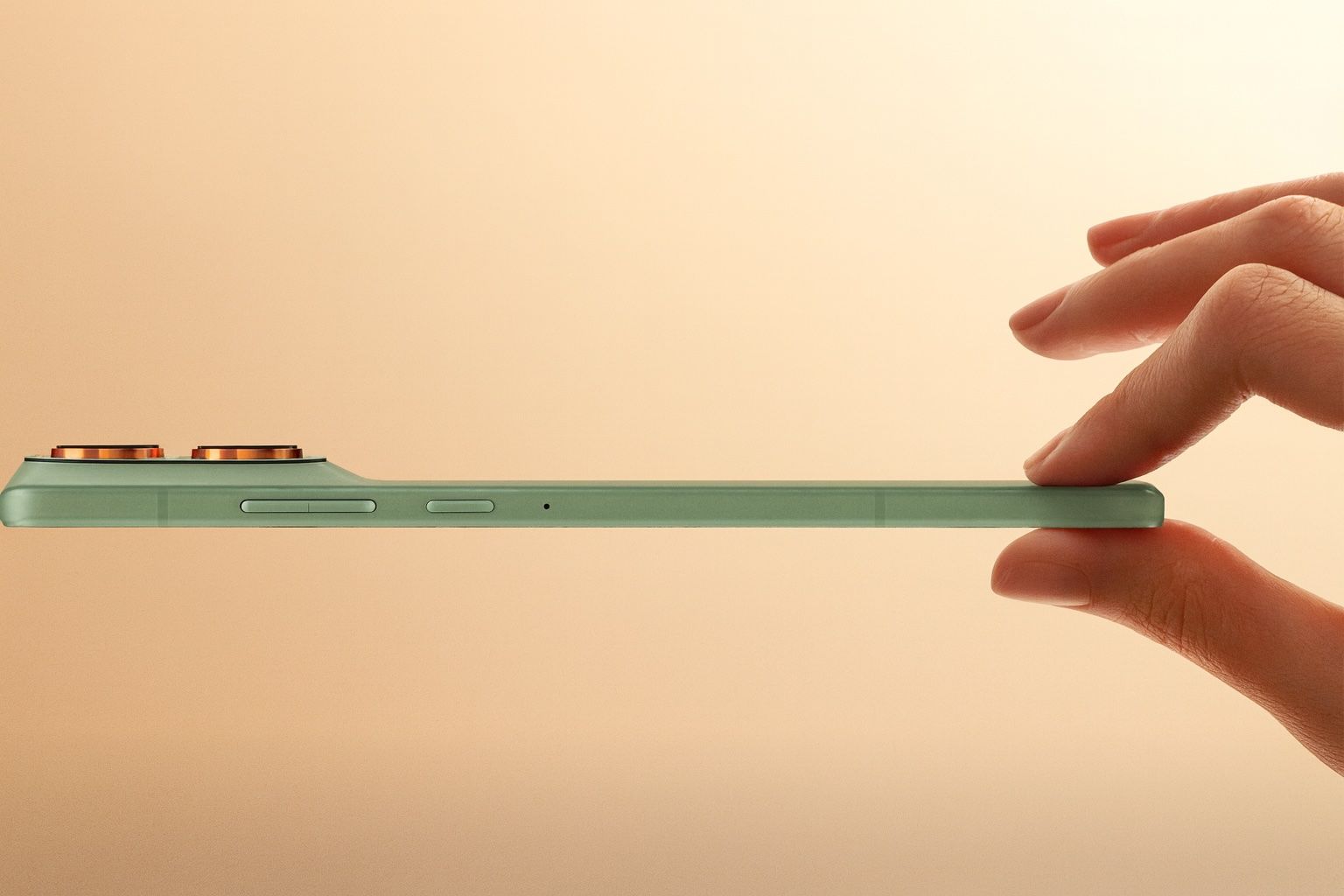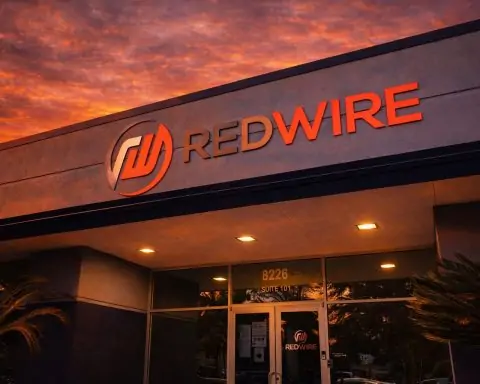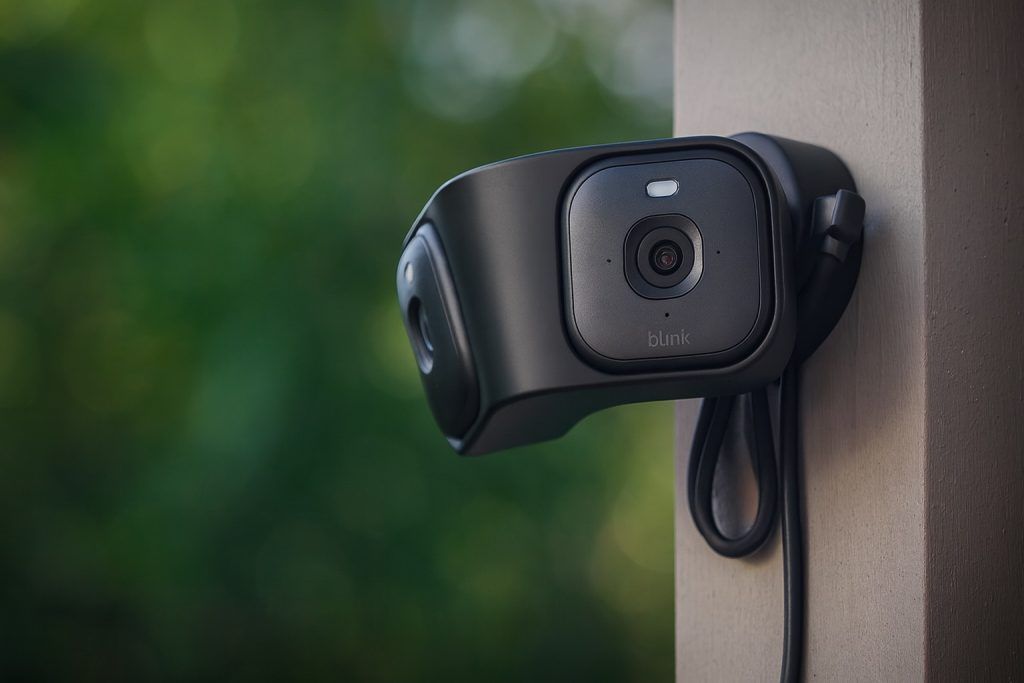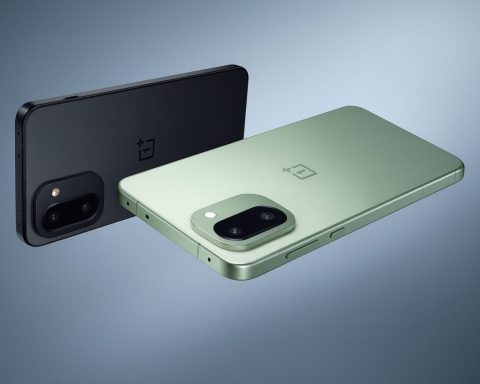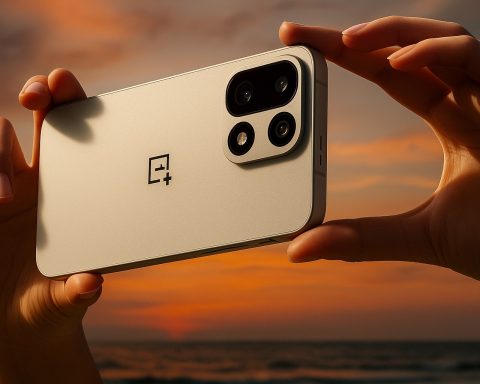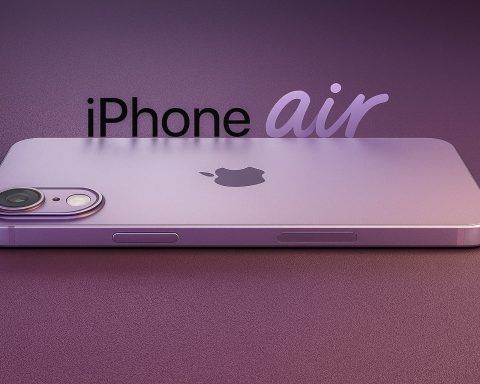- Ultra-slim design: Leaked images and teasers suggest Motorola’s upcoming Edge 70 (aka Moto X70 Air) will be one of the thinnest phones ever [1] [2]. Early renders show an ultra-flat body held between fingers like the new iPhone Air [3].
- Vibrant colors and new styling: Renders reveal the Edge 70 in “Gadget Gray” and “Lily Pad” green, with yellow accents around the cameras and Moto AI button [4] [5]. Unlike previous curved models, it has straight-edged sides, a flat display, and even a top speaker grille hinting at Dolby Atmos audio [6].
- Impressive camera setup: The leaks indicate a 50 MP ultra-wide rear camera (120° field-of-view, OIS, 2.0μm effective pixels after binning) plus at least two other lenses [7] [8]. Motorola’s teaser also emphasizes AI features, and the phone is expected to be powered by Qualcomm’s Snapdragon 8 Gen 5 chipset [9] [10].
- Release timing and price: Motorola China just confirmed the Moto X70 Air will launch in China by end of October 2025 [11]. Historically, Motorola has soon followed Chinese launches with a global “Edge” variant; experts now expect a worldwide Edge 70 debut in late 2025 or early 2026 at a mid-range price [12] [13].
- Tough tagline: Motorola markets the X70 Air/Edge 70 as “impossibly thin and incredibly tough,” a nod to durability (edge phones like the Edge 60 have IP68/IP69 water resistance and MIL-STD-810H ruggedness) [14] [15]. The company seems determined to prove a very slim phone can still handle daily use.
- Industry context: This comes as Apple and Samsung spearhead a new ultra-thin phone trend. Samsung’s Galaxy S25 Edge (5.8 mm thick) is already on sale, and Apple is rumored to follow with an iPhone 17 Air (~5.5 mm) [16] [17]. Motorola’s Edge 70 is likely slightly thicker (around 6–7 mm), but expected to cost far less [18] [19].
Racing to the Slender Limit
Motorola’s latest leaks confirm what insiders have long hinted: it’s jumping into the “ultra-thin” arms race. A promo teaser posted on Motorola’s Weibo (China) shows the X70 Air squeezed between fingertips to highlight its wafer-thin profile [20]. Tech sites note the X70 Air appears to be essentially the Chinese version of the global Motorola Edge 70 [21] [22]. In leaked promo images (widely attributed to tipster Evan Blass), the Edge 70 sports a striking green-and-yellow rear, indicating Motorola’s continued Pantone partnership for eye-catching colors [23] [24].
Sources say the Edge 70 will target the mid-range segment. Despite its slim design, it aims to undercut pricier rivals. As PhoneArena’s Adrian Diaconescu observes, Motorola “knows how to do premium-looking devices with respectable specs and super-competitive price points,” and the Edge 70 is likely no exception [25]. Analysts expect Motorola will price this thin phone well below the likes of the Galaxy S25 Edge or iPhone Air, making ultra-slim design more accessible [26] [27]. Leaks suggest the Edge 70 could be about 6–7 mm thick – not as skinny as Samsung’s 5.8 mm S25 Edge, but impressively slender for its class [28] [29].
Crucially, Motorola is also pushing a robustness narrative. The leaked motto “impossibly thin and incredibly tough” emphasizes durability. The current Edge 60 series is IP68/IP69-rated and meets MIL-STD-810H military standards, and Motorola is likely to carry those credentials over to the Edge 70 [30] [31]. In practice, early rumors say the Edge 70 will pack a Snapdragon 8 Gen 5 processor (Motorola was a Gen 5 launch partner) [32] [33], alongside an AI-specific side button (like on the Edge 60 Pro) for Google Assistant or other smart features [34].
Design & Specs: What We Know So Far
High-quality leaked renders (sourced from YTECHB) show the Edge 70 from every angle [35] [36]. The frames are flat-metal, matching the iPhone Air’s new aesthetic rather than Motorola’s older curved sides. The punch-hole display is also flat, and a small grille on top implies true stereo speakers with Dolby Atmos support [37]. Two colorways are visible: a matte gray (“Gadget Gray”) and a pastel green (“Lily Pad”), both with contrasting yellow rings around the camera cutouts and AI button [38] [39]. Other rumored hues include Bronze Green.
Camera details gleaned from the render text: the ultra-wide camera is listed as 50 MP with a very wide 120° field of view, optical image stabilization, and large 2.0 μm effective pixels (achieved via pixel-binning) [40]. A primary sensor is also 50 MP (with 1.0 μm pixels) and is accompanied by a third, unspecified lens [41]. Motorola typically equips its midrangers with decent cameras, so this setup could compete well if software is good. Early reports do not specify the battery size, but preserving “decent battery life” on such a thin device is a concern noted by analysts (see below).
Software-wise, Motorola is expected to ship the Edge 70 with Android 16 (given its rollout on existing phones) and its usual near-stock Android interface. Pricing is unclear, but observers emphasize Motorola’s strategy is likely volume midrange: PhoneArena suggests the goal is “bringing that [slim] form factor to a more affordable price range,” potentially making ultra-thin phones a new norm if customers embrace it [42].
Ultra-Thin Phone Arms Race
Motorola isn’t alone in this quest for slimness. Samsung kicked off the current trend with the Galaxy S25 Edge (5.8 mm), and plans are already in motion for an even thinner follow-up. Leaks indicate the Galaxy S26 Edge will measure just 5.5 mm at its thinnest point [43] – complete with a beefed-up 4,200 mAh battery to offset the slim chassis [44]. Apple is reportedly responding with the iPhone 17 Air, rumored around 5.5 mm thick as well [45] [46]. (For context, Apple’s earlier iPhone 14 Plus and similar models were around 7.8 mm.)
Other brands are racing in too. Chinese maker Tecno just released the Pova Slim (aka Spark Slim), a mid-range Android at just 5.95 mm thickness – yet it advertises a sizable 5,160 mAh battery [47]. This suggests Chinese OEMs are using advances like silicon-carbon battery tech to push higher capacity into slim frames. As GizChina editor Marco Lancaster notes, these Chinese devices “allow manufacturers to fit more energy without expanding the footprint” [48].
Samsung’s Galaxy S26 Edge, Apple’s iPhone Air series, and now Motorola’s Edge 70 all trade on the appeal of novelty. Tech analyst Lancaster writes that manufacturers may simply be “manufacturing a new desire to stand out in a crowded market,” making thinness “the next big thing” rather than responding to explicit consumer demand [49]. Indeed, some commentators wonder if average buyers truly want glass-thin phones or if this is just a marketing flash.
Trade-Offs: Battery and Durability
The biggest trade-off for extreme slimness is battery life. As GizChina bluntly puts it: “Phones can only shrink so much before something essential gets cut. The biggest casualty is obvious: battery capacity.” [50]. For example, Samsung’s Galaxy S25 Edge – at 5.8 mm thin – only has a 3,900 mAh battery [51], modest by today’s standards (many thick flagships exceed 6,000 mAh). Motorola’s Edge 70 will presumably need a smaller battery than a typical mid-ranger unless it uses cutting-edge cell tech.
Motorola is banking on efficiency gains (powerful yet power-efficient chips) and on the notion that mid-range buyers might tolerate a bit less endurance for an eye-catching design. Indeed, the Android Police/Verge commentary argues that a mid-range Edge 70 could achieve “better battery life than you’ll get from the iPhone Air and Galaxy S25 Edge,” since it may have “midrange power” rather than flagship-level hardware [52]. (We were unable to access that article directly due to access issues, but its summary suggests Motorola’s strategy: enough performance without the high power draw of $1,000+ phones.)
Durability is another concern. Historically, the thinnest phones (like Oppo’s 4.85 mm R5 from 2014) were easy to bend or damage. Samsung and Apple claim their new edge/air phones are surprisingly stiff despite thin glass, partly due to metal frames and internal supports. Motorola hints it will do the same: the emphasis on “toughness” in its marketing implies reinforced chassis and coatings. PhoneArena notes the Edge 60 series was already rugged (IP68/69 and MIL-STD protection) [53], so “incredibly tough” Edge 70 models will likely retain heavy-duty build quality.
In short, experts caution that ultra-thin designs involve inevitable compromises – smaller battery, tighter thermal margins, and repairability challenges. A GizChina editorial warns a super-thin phone “could be interesting” with new battery tech, but until breakthroughs arrive, ultra-slim flagships are more marketing than meaningful user improvement [54] [55]. That said, many consumers do find ultra-light phones easier to pocket and hold, so if Motorola and others balance the specs wisely, the niche appeal could grow.
What Experts Are Saying
Tech writers are watching this trend closely. PhoneArena’s Ilia Temelkov summarizes Motorola’s move as mainstreaming a futuristic design: “Edge 70 won’t directly challenge the Galaxy S25 Edge and the iPhone Air. Instead, Motorola will bring that form factor to a more affordable price range, which could help it become the norm” [56]. In other words, ultra-thin phones might spread from pricey flagships down to everyday models if users accept the trade-offs.
Asif Iqbal of SamMobile adds that Motorola’s teaser “looks just like some of the promotional materials for the iPhone Air,” implying a direct shot at the Apple-Samsung baton pass in thinness [57] [58]. He notes Motorola’s Chinese teaser says the phone could be “sub-6 mm thin,” on par with the latest Samsung and Apple slimmest phones [59]. Motorola has even dubbed the Chinese model “X70 Air,” echoing Apple’s naming.
Meanwhile, YugaTech remarks that Motorola “is the latest brand to join the ultra-thin smartphone trend,” highlighting its competition with the S25 Edge, iPhone Air, and even Tecno’s Spark Slim [60]. YugaTech also reports the leaked tagline “incredibly thin and incredibly tough,” suggesting Motorola wants a thin phone that can take a beating [61].
Consumer reaction is mixed. In PhoneArena polls, about 68% of readers said they’d buy a super-slim Motorola if it were a flagship or a mid-range phone [62]. (Very few want a “thick phone” as a lifestyle statement.) But comment threads show some skepticism about sacrificing battery for the “wow” factor. Many await formal reviews and battery-life tests.
The Bottom Line
Motorola’s Edge 70 (Moto X70 Air) is poised to be a splashy entrant in a resurging trend of paper-thin phones. With leaked renders showing a flat-edges, stylish colors, and Dolby Atmos speakers, it promises a premium look. Its “impossibly thin” design, if realized, will directly challenge fanboy talking points about Samsung’s and Apple’s latest slimmest models – but (crucially) at a likely much lower price.
However, experts urge caution: ultra-slim form factors always involve compromises. Battery capacity, thermal management, and repairability may all be sacrificed for fashion. As GizChina editorializes: slim designs are “not progress” if a phone “dies before the end of the workday” [63]. Motorola seems aware of this tension, emphasizing toughness and mid-range value in its messaging.
In short, Motorola’s leaked Edge 70 suggests the ultra-thin trend is expanding beyond niche flagships. The coming months will tell if consumers truly embrace featherweight phones, or if it’s just another novelty. For now, tech-watchers will be eyeing October for the X70 Air’s China debut, and the global Edge 70’s eventual release, to see if Motorola has struck the right balance of thinness, durability, and battery life [64] [65].
Sources: Leaked renders and official teasers (PhoneArena, SamMobile, YugaTech) [66] [67] [68] [69]; editorials and analysis (GizChina) [70] [71]; industry leaks and rumors (Samsung S26 Edge CAD render details) [72] [73]; Qualcomm and chipset news. All cited above.
References
1. www.phonearena.com, 2. www.yugatech.com, 3. www.phonearena.com, 4. www.phonearena.com, 5. www.phonearena.com, 6. www.phonearena.com, 7. www.phonearena.com, 8. www.sammobile.com, 9. www.phonearena.com, 10. www.yugatech.com, 11. www.phonearena.com, 12. www.phonearena.com, 13. www.yugatech.com, 14. www.phonearena.com, 15. www.sammobile.com, 16. www.gizchina.com, 17. www.sammobile.com, 18. www.phonearena.com, 19. www.phonearena.com, 20. www.phonearena.com, 21. www.phonearena.com, 22. www.phonearena.com, 23. www.phonearena.com, 24. www.phonearena.com, 25. www.phonearena.com, 26. www.phonearena.com, 27. www.phonearena.com, 28. www.phonearena.com, 29. www.sammobile.com, 30. www.phonearena.com, 31. www.sammobile.com, 32. www.phonearena.com, 33. www.yugatech.com, 34. www.phonearena.com, 35. www.phonearena.com, 36. www.phonearena.com, 37. www.phonearena.com, 38. www.phonearena.com, 39. www.phonearena.com, 40. www.phonearena.com, 41. www.sammobile.com, 42. www.phonearena.com, 43. www.androidheadlines.com, 44. www.androidheadlines.com, 45. www.gizchina.com, 46. www.androidheadlines.com, 47. www.sammobile.com, 48. www.gizchina.com, 49. www.gizchina.com, 50. www.gizchina.com, 51. www.gizchina.com, 52. tech.yahoo.com, 53. www.phonearena.com, 54. www.gizchina.com, 55. www.gizchina.com, 56. www.phonearena.com, 57. www.phonearena.com, 58. www.sammobile.com, 59. www.sammobile.com, 60. www.yugatech.com, 61. www.yugatech.com, 62. www.phonearena.com, 63. www.gizchina.com, 64. www.phonearena.com, 65. www.phonearena.com, 66. www.phonearena.com, 67. www.phonearena.com, 68. www.sammobile.com, 69. www.yugatech.com, 70. www.gizchina.com, 71. www.gizchina.com, 72. www.androidheadlines.com, 73. www.androidheadlines.com
